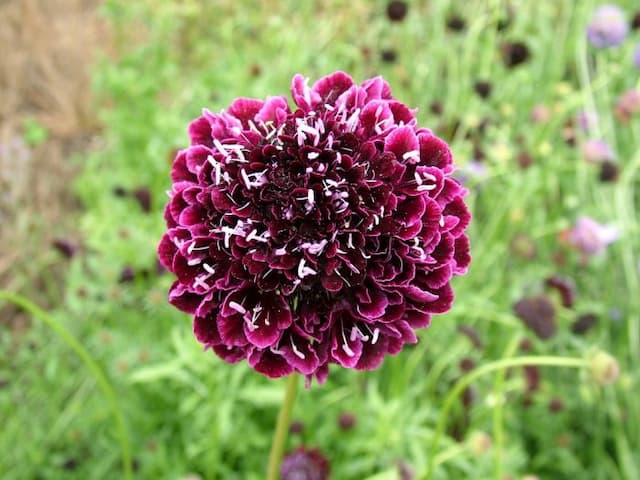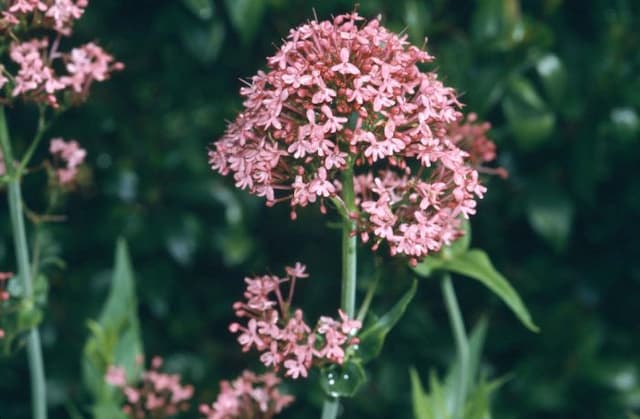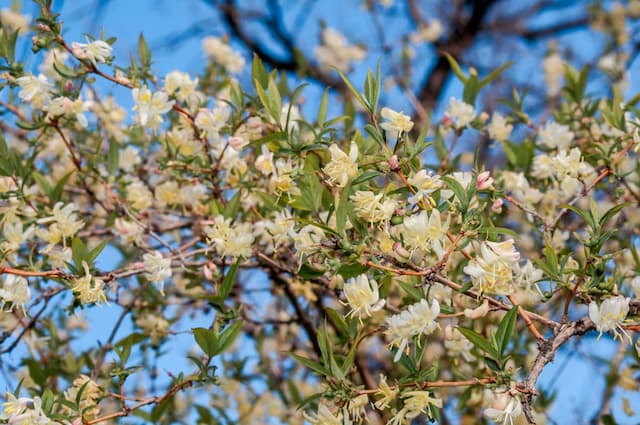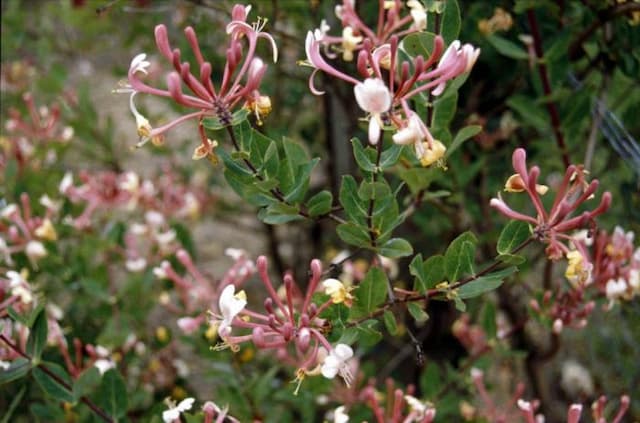Glossy Abelia Abelia × grandiflora 'Sherwoodii'

ABOUT
Abelia 'Sherwoodii' is a graceful shrub that showcases a beautiful, mounded form with arching branches that provide an elegant garden silhouette. Its leaves are small, glossy, and oval-shaped, displaying a rich green color throughout the growing season. As the seasons change, the foliage adopts a bronzy hue, adding a touch of warm color to the autumn landscape. One of the most striking features of Abelia 'Sherwoodii' is its abundant floral display. The plant blooms profusely with clusters of small, trumpet-shaped flowers. These blossoms are typically pale pink or white, and they have a light, sweet fragrance that is attractive to both humans and pollinators like bees and butterflies. The flowers emerge from the delicate pink sepals that remain on the plant after the petals have fallen, giving it a long season of visual interest. The overall texture of Abelia 'Sherwoodii' is fine to medium, with the interplay of its dainty flowers against the glossy leaves creating a visually stunning combination. The shrub can serve as an excellent backdrop for other perennials or as a feature in a foundation planting due to its graceful form and lengthy flowering period. As seasons transition, the Abelia 'Sherwoodii' continues to captivate with its foliage and persistent sepals, ensuring it remains a focal point in the garden for much of the year.
About this plant
 Names
NamesFamily
Caprifoliaceae
Synonyms
Glossy Abelia, Sherwood Abelia
Common names
Abelia × grandiflora 'Sherwoodii'.
 Toxicity
ToxicityTo humans
Abelia is generally considered non-toxic to humans. There are no well-documented cases of poisoning from consuming any part of this plant. However, as with many plants, individual sensitivities can vary, so it’s always advisable to avoid ingesting plant parts without proper knowledge of their edibility and potential effects.
To pets
Abelia is also generally recognized as non-toxic to pets, including dogs and cats. It is not known to cause any significant symptoms of poisoning if pets ingest parts of the plant. Despite being non-toxic, pets consuming Abelia may occasionally experience mild gastrointestinal upset simply due to the ingestion of non-food items. Owners should always monitor their animals after they have eaten plant material, even those considered non-toxic, and consult a veterinarian if any unusual signs arise.
 Characteristics
CharacteristicsLife cycle
Perennials
Foliage type
Semi-deciduous
Color of leaves
Green
Flower color
White
Height
3-5 feet (0.91-1.52 meters)
Spread
3-5 feet (0.91-1.52 meters)
Plant type
Shrub
Hardiness zones
6
Native area
Mexico
Benefits
 General Benefits
General Benefits- Attractive Foliage: Abelia 'Sherwoodii' has glossy, semi-evergreen leaves that provide year-round interest in the garden.
- Long Flowering Season: It blooms from early summer to autumn, offering an extended display of small, tubular, and fragrant flowers.
- Wildlife Attraction: The flowers are popular with pollinators such as bees and butterflies, supporting biodiversity.
- Low Maintenance: Abelia 'Sherwoodii' is easy to care for, requiring minimal pruning and is resistant to most pests and diseases.
- Drought Tolerant: Once established, it has good drought tolerance, making it suitable for regions with water restrictions.
- Versatile Landscaping: This plant is excellent for use in mixed borders, as a foundation plant, or for creating low hedges.
- Color Variety: The foliage sometimes turns bronze in autumn, adding an additional color aspect to the plant's profile.
- Compact Size: Its relatively small size makes it suitable for gardens where space is limited.
 Medical Properties
Medical PropertiesThis plant is not used for medical purposes.
 Air-purifying Qualities
Air-purifying QualitiesThis plant is not specifically known for air purifying qualities.
 Other Uses
Other Uses- Photography Backdrop: Abelia can be grown and pruned into dense hedges that make a lush, green background for outdoor portrait photography.
- Living Fence: With its dense foliage and semi-evergreen habit, Abelia 'Sherwoodii' can be planted in rows to create a living fence that provides privacy and sound attenuation.
- Bonsai: Due to its small leaves and attractive flowers, this plant can be trained into a bonsai for ornamental purposes.
- Erosion Control: On sloping gardens, its root system helps to stabilize the soil and prevent erosion.
- Shade Garden Accent: Abelia 'Sherwoodii' can be used in shade gardens to provide structure and interest with its arching branches.
- Wildlife Shelter: The dense foliage offers shelter and nesting sites for birds and beneficial insects.
- Themed Gardens: Abelia 'Sherwoodii' can be incorporated into fairy or miniature gardens due to its small flowers and manageable size.
- Topiary: Can be trained into specific shapes and structures as part of garden art or topiary displays.
- Seasonal Interest: The foliage changes color in the fall, adding seasonal interest to the garden with shades of bronze, red, or purple.
- Urban Planting: Resilient against pollution, it can be planted in urban areas to add greenery and improve the landscape.
Interesting Facts
 Feng Shui
Feng ShuiThe Glossy Abelia is not used in Feng Shui practice.
 Zodiac Sign Compitability
Zodiac Sign CompitabilityThe Glossy Abelia is not used in astrology practice.
 Plant Symbolism
Plant Symbolism- Adaptability: Abelia × grandiflora 'Sherwoodii', or Glossy Abelia, is known for its ability to thrive in various soil types and weather conditions, making it a symbol of adaptability.
- Longevity: With its long blooming season, the Glossy Abelia symbolizes endurance and the ability to sustain beauty over time.
- Rejuvenation: The plant's tendency to produce new growth and flowers throughout the season conveys a sense of renewal and rejuvenation.
- Attraction: The sweet fragrance and delicate flowers of the Glossy Abelia are attractive to pollinators, symbolizing allure and magnetism in the natural world.
 Water
WaterThe Glossy Abelia should be watered deeply once a week, providing about an inch of water each time. During the hotter summer months, it may require additional water, especially if there are prolonged periods of dry weather. It's important to check the soil moisture level regularly; the soil should be moist but not waterlogged. Overwatering can lead to root rot, so reduce the frequency to every other week during the cooler months or if rainfall is adequate. It's best to water the plant at the base, avoiding overhead watering to prevent leaf diseases.
 Light
LightThe Glossy Abelia thrives in full sun to partial shade. It should be placed in a location where it can receive at least six hours of sunlight daily for optimal blooming. However, in regions with very hot summers, providing afternoon shade can help protect the plant from excessive heat.
 Temperature
TemperatureThe Glossy Abelia is hardy and can tolerate a range of temperatures, generally surviving winters in USDA zones 6 through 9. It can withstand minimum temperatures down to about 0°F, while the ideal growing temperatures are between 65°F and 75°F. The plant can handle heat well but should be protected from severe cold snaps.
 Pruning
PruningPruning the Glossy Abelia is essential to maintain its shape and encourage fuller growth. Prune in late winter or early spring before new growth begins. Remove any dead or crossed branches and trim back by about one-third of the previous year's growth to promote new flower buds. Pruning can be done annually or as needed to keep the plant tidy.
 Cleaning
CleaningAs needed
 Soil
SoilGlossy Abelia prefers well-draining soil with a high organic matter content and a slightly acidic to neutral pH between 5.5 to 7.0. A mix of loam, peat moss or compost, and some sand or perlite is ideal for providing proper drainage and fertility.
 Repotting
RepottingGlossy Abelia doesn't often require repotting as it is usually grown outdoors; however, if grown in containers, repotting every 2 to 3 years or when roots become crowded is adequate.
 Humidity & Misting
Humidity & MistingGlossy Abelia is tolerant of a range of humidity levels and does well in average outdoor conditions without the need for specific humidity adjustments.
 Suitable locations
Suitable locationsIndoor
Needs bright light; keep in a cool room.
Outdoor
Plant in sun or part-shade; protect from harsh winds.
Hardiness zone
6-9 USDA
 Life cycle
Life cycleAbelia × grandiflora 'Sherwoodii', commonly known as Glossy Abelia, begins its life cycle as a seed which, upon germination, develops into a young seedling. As the seedling grows, it matures into a flowering shrub with arching branches, typically reaching a height of 3-6 feet. During spring and summer, the shrub produces clusters of small, tubular flowers that are pink to white in color and attract pollinators such as bees and butterflies. After pollination, the flowers develop into seed capsules, which eventually release seeds, completing the reproductive cycle. Throughout its life, Glossy Abelia will undergo periods of active growth followed by dormancy, typically in response to seasonal changes. With proper care and favorable conditions, this shrub can live and thrive for several years, often requiring pruning to maintain shape and encourage blooming.
 Propogation
PropogationPropogation time
Late spring to early summer
The best time for propagating Abelia × grandiflora 'Sherwoodii', commonly known as Glossy Abelia, is in late winter to early spring. The most popular method of propagation for this plant is through softwood cuttings. To do this, take cuttings of about 4 to 6 inches (10 to 15 cm) in length from new growth that is just beginning to harden. The leaves on the lower half of the cutting should be removed, and the cut end dipped in rooting hormone to encourage root development. The treated cutting is then inserted into a well-draining soil mix and kept under high humidity and indirect light until roots establish. Rooting success is typically higher when bottom heat is provided, keeping the soil temperature around 70°F (21°C). Once rooted, the cuttings can be potted up individually and gradually acclimated to less humid conditions before planting out.









